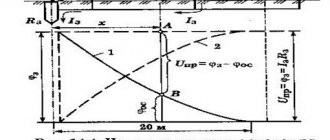Current and voltage: distinctive qualities
Electrical energy is a whole complex of values and indicators. In this case, voltage is a characteristic of potential energy that can reach an object as much as possible. At the same time, current is the very effect on the object that occurs between the points of the circuit.
Let's look at the principle of the existence of electricity as an example. It is known that any substance contains billions of atoms. Negatively charged electrons orbit around a (positively charged) nucleus. In this case, there is no close interaction between particles. But as soon as the electromagnetic field begins to interact with them, the particles around the nucleus will begin to move. Due to this, a charge of a certain strength is formed. It binds particles. It is customary to call it current.
Character of current and voltage
Since current and voltage are interconnected concepts, their combination can be divided into three groups according to their nature:
- Constant. In this case, there is no dependence whether there is a load or no load, the current and voltage will be constant, without changing when in contact with something. Typically, such electricity can be found in sources of unlimited power.
- Variable depending on load. This current is a component of sources that have limited power. The voltage will decrease if the electrical circuit is shorted.
- Temporary. If a load is connected to a power source, then the entire charge will be completely dissipated after a short period of time. This usually happens with capacitors.
Obviously, electric current is not able to flow through a circuit unless a load is fixed on it.
How do current and voltage affect the human body?
To understand what you should be afraid of: electric current or voltage, you need to know what and how it affects a person. More on this below.
From electrical engineering we can recall that the human body is a solution of salts and other organic substances in water. It turns out that if the current comes into contact with the body, then, accordingly, the body will receive a shock. Since electricity also “loves” water.
You cannot use electrical appliances and water at the same time Source elektrik-a.su
It turns out that if the current passes through the entire body, then with a high probability the person will receive injuries of various types:
- Thermal. All parts of the body through which electricity will pass will heat up. As a result, there is a risk of receiving external and internal burns that are incompatible with life.
- Electrolytic. Chemical reactions occur in the blood and other fluids of the human body, which can also cause instant death. Such interference prevents the body from functioning normally.
- Biological. In this case, irritation of the nerve endings of the skin and other organs that have them occurs.
- Mechanical. No less dangerous than others. As a result of this impact, ruptures of soft tissues and internal organs occur. Even bone fractures in joints and ligaments are possible.
Electrical injuries that a person received can be divided into three groups:
- are common. As a result, complete damage to the human body occurs under the influence of electric current;
- local. Only those places through which the current passed remain affected (usually they are recorded in the form of ruptures or burns);
- eye burns. Occur when exposed to an electric arc caused by ultraviolet radiation.
On a note! All of the electrical injuries listed may be incompatible with life, so you should not assume that any of them can be safe.
Electric shock can be fatal, so do not ignore these signs Source hronika.info
What is meant by dangerous current for humans?
To avoid undesirable consequences, you must understand that any current can be considered dangerous. Objections that electricity is often used for medical purposes, in particular in electrophoresis, and it does not pose a threat to humans, are partly true. It is necessary to remember such a parameter as time. The longer the contact of a body area with the conductor, the higher the likelihood of a negative manifestation.
In some sources you can find information that a dangerous current for humans is a value of 0.05 mA, while in others you can find values of 0.1 mA. As noted above, all this data should be taken as reference information. And even more so, you should not, after measuring the current strength with a multimeter, start repairing live equipment. There are people who, due to the characteristics of their body, can safely work under a voltage of 220 V and not experience discomfort. But for some, even several times smaller values may turn out to be incompatible with life.
How does the effect of dangerous current manifest itself?
It can be unequivocally stated that the current strength can be considered dangerous, under the influence of which the consequences are traumatic in nature, but the person remains alive. The injury occurs in the form of a thermal burn and may be accompanied by:
- redness of the body area at the point of contact;
- the formation of blisters and necrosis of the upper and middle layers of the skin;
- charring of tissues, muscles and bones.
The degree of damage and what it depends on
The question is often asked what current and voltage are considered dangerous. This depends on various factors, but it is the electrical resistance of the skin that deserves special attention. For example, if there is no moisture on the surface, it is absolutely dry, then the resistance will be about 100 kOhm, with an applied voltage of 5-10 V.
In case the skin is wet or has even a slight percentage of moisture, then it drops to 1 kOhm. Accordingly, the electric shock will be many times stronger and the damage will be very serious. The resistance of internal organs, regardless of the condition of the skin, will be from 0.5 to 1 kOhm. Poor health also negatively affects the resistance ability of the human body.
The lower the resistance, the higher the exposure to electricity. Also, damage from current increases with prolonged exposure to a person and poor health: this includes cardiovascular diseases, diseases of the circulatory and respiratory systems.
The degree of damage may also depend on the path the electric current took when passing through the body. The most dangerous are considered to be: arm-legs and arm-arm. In such cases, it passes through the chest, accordingly affecting the organs that are located in it.
Important! The higher the current and voltage, the faster it will flow along its path. For example, 65V -1 second; 220 - 0.1 second.
All work with electricity must be carried out in compliance with safety requirements Source cgsinc.com
Which current is more dangerous for human life
Alternating current is used much more often in industry and everyday life. People have long been accustomed to this and few people know that in the 19th century Nikola Tesla and Thomas Edison launched a real “current war”, the results of which determined the further path of industrial development.
Conductor of electricity
One of the arguments given by Edison in defense of direct current was its lower danger to humans compared to alternating current. Under the same conditions (up to 500 V), the force of alternating current on the body is 2-4 times higher.
We advise you to study What is twisted pair
In the end, the AC concept won. It is much lighter and transmits over long distances with less loss, is easily converted, and is more convenient for the operation of electric motors.
The effects of electric current on the human body:
- Thermal (up to 60%) - heating of the skin and internal tissues up to burns;
- Electrolytic - decomposition and disruption of the physical and chemical composition of organic liquids (blood, lymph);
- Mechanical - stratification and rupture of internal organs under the influence of electrodynamic shock;
- Biological - convulsive contractions of muscle and nervous tissue.
Attention! Loss of consciousness, as well as disruption of the heart and lungs, occurs when the frequency of the electrical flow and heart contractions coincide
Variable
An electric current that changes in magnitude and direction over time. The flow of electrons constantly oscillates at a certain frequency.
Sinusoid of electron motion
Why is alternating current more dangerous for human life than direct current?
- By its nature, it causes stimulation of the nervous system, contraction and relaxation of muscles, which increases the likelihood of atrial fibrillation, leading to cardiac arrest;
- The frequency of the passing pulse reduces the resistance of the human body;
- An electrical conductor carrying alternating current has a high attractive force.
On a note! The upper limit of alternating current strength that does not lead to damage or serious consequences is 1.2 mA.
Constant
Electric current is the movement of charged particles from minus to plus, the polarity and voltage of which are constant. The flow of electrons goes strictly in a straight line without fluctuations. The severity of the lesion is directly proportional to the amount of voltage applied.
DC generator
Reasons for the lower danger of direct current compared to alternating current:
- Causes muscle spasm, but does not lead to cardiac dysfunction;
- The resistance of the human body is higher when the electron oscillation frequency is zero;
- A single blow allows you to quickly stop direct contact with an electrical conductor, throws a person back, reducing the duration of exposure to damaging factors on the body.
Attention! The upper limit of safe exposure to direct current is much higher - 7 mA. Comparison of the effects of alternating and direct electric currents on the body to find out which current is more dangerous
Comparison of the effects of alternating and direct electric currents on the body to find out which current is more dangerous.
| Electric current strength (mA) | Alternating current | D.C |
| 0,6–1,5 | Slight tingling | No sensations |
| 2–3 | Mild cramps | -«- |
| 5–7 | Severe cramps | Slight tingling, slight sensation of warmth |
| 8–10 | Severe pain, the upper threshold of the ability to open your hands independently | Symptoms of skin tingling and heating increase |
| 20–25 | Paralysis of limbs, inability to release the current source | Mild cramps, strong heating of the skin |
| 50–80 | Cardiac dysfunction, respiratory center paralysis | Difficulty breathing, severe convulsive spasms |
| 90–100 | Respiratory arrest, possible atrial fibrillation | Paralysis of the respiratory system, the likelihood of the victim being thrown back, causing physical injury |
| 200–300 | When exposed to more than 0.1 s, cardiac arrest, tissue destruction | Thermal destruction of tissues |
Note! It is important to know what current is life-threatening - 50-100 mA, more than 100 mA - fatal. Assistance in case of electrical injury
Providing assistance in case of electrical injury
How is current felt by a person?
The human body can feel the effects of electric current on it in different ways. Everything depends on his strength. There are:
- 1-10 mA. This current is not felt by humans. He will be able to independently release a current-carrying object without a threat to health and life;
- 15-50 mA. A current of such strength will irritate the muscles and cause pain. It will be problematic to release the conductor on your own.
- 50-100 mA. This current intensity affects the heart muscle and is therefore life-threatening. It is impossible to power yourself using electricity;
- 100-200 mA. Exposure to such current is extremely dangerous. It not only causes critical harm to health, but is also likely to be fatal.
Protective dielectric gloves should be used when in contact with electrical conductors Source ligmasters.rf
An electrical transformer can cause electric shock Source lenta.ru
What are the dangers of electric shock?
When exposed to electrical voltage, the victim always receives a shock, but its consequences can be different: from cramps of the fingers and trembling, from unpleasant sensations of heating and burning to respiratory arrest and cardiac fibrillation (unsystematic contraction) and its complete stop. In the latter case, blood stops moving through the vessels, causing the person to die. In addition, electric current is dangerous for humans, since at certain values of its strength it creates the effect of sticking to bare wires due to excessive stimulation of nerve fibers by electricity. One of the causes of death from electric shock can be mechanical injury as a result of involuntary muscle contraction. Loss of vision may occur due to the impact of the resulting electric arc on the retina.
The skin on the face, neck and back of the hands is most affected by the effects of electric current.
Note! Certain (acupuncture) points on a person’s ears and neck are extremely susceptible to electricity - if they are hit, even a weak current can kill the victim. The passage of an electric charge through a person’s body leaves peculiar marks on it - the so-called
"electrical marks", which are dead skin with a yellow coating, similar to calluses
The passage of an electric charge through a person’s body leaves peculiar o’s on it, which are dead skin with a yellow coating, similar to calloused formations.
Electric current passing through the body leaves its marks
An electrical burn causes redness of the skin at the point of contact with its source, bubbles with physiological fluid inside are inflated, areas of the body become charred and blackened, sometimes pieces of metal or fabric from clothing are literally “melted” into them. Such burn injuries are treated worse than simple thermal burns; they do not always appear immediately - the consequences can become visible after hours, days or even months (therefore, all victims are under the supervision of doctors for a long time).
The most dangerous current is that which enters the areas of the back, hands, temporal and occipital parts of the head.
The extent of health damage from electric shock depends on the direction of current movement inside the human body. As a rule, there are several “routes” for the passage of charge. The fatal path of current for a person is the path from one hand holding a bare wire to the other, because it goes through the lungs, bronchi and heart muscle and causes them to fibrillate. If the victim holds onto a source containing direct current with one hand and stands with his feet on the ground, the route is called “hand-foot”, in which case the electricity disrupts the functioning of almost all internal organs and, of course, the heart muscle. The “road” of electricity through the head to the arms or legs is also fatal: if the victim touches live elements with his head. Sometimes people experience electrical injury from the so-called. “step voltage”, when they are on the ground that receives electric direct current without grounding, it passes through the body only through the legs, the heart does not suffer.
We advise you to study Electricity transmission over a distance
Routes along which direct current passes in the human body










